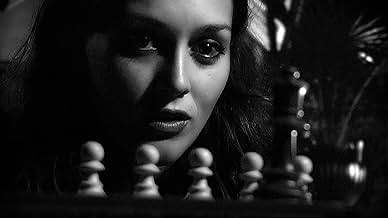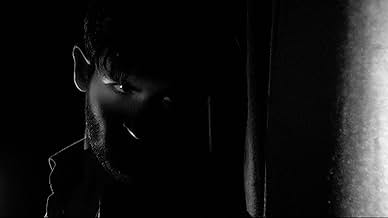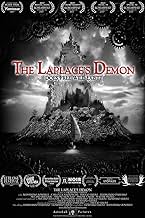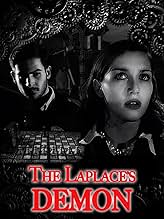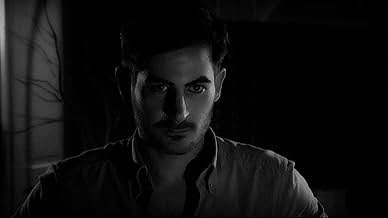Un gruppo di ricercatori ha sviluppato un sistema in grado di calcolare l'evolvere di eventi apparentemente casuali. Vengono invitati dal misterioso professor Cornelius nella sua isola in me... Leggi tuttoUn gruppo di ricercatori ha sviluppato un sistema in grado di calcolare l'evolvere di eventi apparentemente casuali. Vengono invitati dal misterioso professor Cornelius nella sua isola in mezzo all'oceano. Devono solo passare lì la notte.Un gruppo di ricercatori ha sviluppato un sistema in grado di calcolare l'evolvere di eventi apparentemente casuali. Vengono invitati dal misterioso professor Cornelius nella sua isola in mezzo all'oceano. Devono solo passare lì la notte.
- Regia
- Sceneggiatura
- Star
- Premi
- 5 vittorie e 3 candidature totali
Recensioni in evidenza
A group of researchers have developed a system that enables them to calculate seemingly random events, i.e., how many pieces a glass will shatter into when dropped from a table to the floor. Their studies attract the attention of a mysterious Professor, who invites them to his very remote house on top of a very steep rock in the middle of the ocean. But when they arrive, the Professor is not there, and instead he invites them to take part in an experiment of his devising. All they have to do is survive until dawn
. This is a first feature from writer/director/actor Giordano Giulivi, and it's absolutely wonderful. Montreal's FantAsia Festival 2017 was privileged to have the world premiere, complete with director and others involved at the screening; he mentioned that it took his filmmaking team 7 ½ years to make this film and it's easy to see why, given the really beautiful look of the (black and white) film, its atmospheric qualities and it's combination of incredibly detailed mechanistic movement via cogs and wheels along with the occasional pause for the actors to have a philosophical discussion about the meaning of life. Very Italian, very wonderful!
A glass in free fall. Have you ever thought if it is possible to calculate into how many pieces it can break into? After numerous experiments, a team of researchers succeeds in doing just this apparently impossible task. Attracted to their experiment, a mysterious professor invites the scientists in his isolated mansion to know more about their studies.
This film was intriguing before the first frame because of its name: "The Laplace's Demon". Anyone who knows philosophy or physics will recognize Laplace as a strong promoter of classic mechanics and therefore determinism. His "demon" could theoretically predict the future because all atoms move in a set pattern. Not unlike LaMettrie, his ideas strongly suggested a predictable, deterministic world was not just theory but reality. And, sure enough, this factors into the film at hand.
The concept of being able to accurately predict how many piece a glass will shatter into has some physics potential, but it has even more philosophical potential. And we see this when the scientists reach the mansion – as they have seemingly achieved a limited understanding of determinism, it is fitting that they themselves become pawns (literally) and their every move is predicted by forces unknown.
Due to the philosophical nature of the film, and its monochrome cinematography, it is being compared to the original "Twilight Zone". This is a fair comparison, and indeed it would fit in well alongside some of Rod Serling's finest scripts. But another fair comparison is to the work of Guy Maddin. Somehow we find ourselves in a rather timeless world, much like Maddin's throwbacks to Eisenstein. We know the film takes place in modern times because of the computers and such, but the look still has something of a retro or antiquated feel. The mansion itself would fit in well in a "dark house" film of the 1930s.
Going any further might risk giving too much away. The film does have some odd quirks about it, such as an Italian man named Jim Bob. Really? But all things considered, this is a great film and one that will make the brain wrinkle a little bit more than usual. "Laplace's Demon" screens July 21, 2017 at the Fantasia International Film Festival.
This film was intriguing before the first frame because of its name: "The Laplace's Demon". Anyone who knows philosophy or physics will recognize Laplace as a strong promoter of classic mechanics and therefore determinism. His "demon" could theoretically predict the future because all atoms move in a set pattern. Not unlike LaMettrie, his ideas strongly suggested a predictable, deterministic world was not just theory but reality. And, sure enough, this factors into the film at hand.
The concept of being able to accurately predict how many piece a glass will shatter into has some physics potential, but it has even more philosophical potential. And we see this when the scientists reach the mansion – as they have seemingly achieved a limited understanding of determinism, it is fitting that they themselves become pawns (literally) and their every move is predicted by forces unknown.
Due to the philosophical nature of the film, and its monochrome cinematography, it is being compared to the original "Twilight Zone". This is a fair comparison, and indeed it would fit in well alongside some of Rod Serling's finest scripts. But another fair comparison is to the work of Guy Maddin. Somehow we find ourselves in a rather timeless world, much like Maddin's throwbacks to Eisenstein. We know the film takes place in modern times because of the computers and such, but the look still has something of a retro or antiquated feel. The mansion itself would fit in well in a "dark house" film of the 1930s.
Going any further might risk giving too much away. The film does have some odd quirks about it, such as an Italian man named Jim Bob. Really? But all things considered, this is a great film and one that will make the brain wrinkle a little bit more than usual. "Laplace's Demon" screens July 21, 2017 at the Fantasia International Film Festival.
Marquis Pierre Simon Laplace was one of the most notable French intellectual of the 18th century whose work influenced the scientific fields of mathematics, physics and astronomy. Laplace is widely known for his -almost theological- faith in the purely deterministic nature of the existing world, where an intellect capable to comprehend and analyse the position of all "items of which nature is composed" would find the future no more mysterious than the past. This is a theory that nowadays, in the light of modern approaches especially in the quantum mechanics, seems obsolete, even irrelevant, but this fact doesn't prevent it from being a totally compelling premise for an intriguing film which transcends a number of different genres such as science fiction, crime fiction, horror and others.
''Laplace's Demon'' begins when a number of young scientists are invited by a mysterious super-researcher in his mansion, literally in the middle of nowhere in order to participate in a self-invented experiment which aims to show that everything, including the diverse human behavior, can be totally predicted by a mathematical formula. When they enter the -terrifying- estate they soon realize that they were invited there in order to be killed one by one by an uknown force which takes the form of the chess piece of regina. Gradually, realizing the terrible truth behind the bizarre invitation by the shady professor, they will have to find a way to move as unpredictable as possible, thus to deconstruct and finally destroy the experiment itself.
This is a movie that is shot in black and white, a fact that adds to the gloomy and grotesque feeling that permeates the story as a whole. There is also some great dialogue regarding fundamental philosophical and scientific questions about the possibility of a world where free choice is nothing more but a mere illusion, a concept created by the human need to believe that himself is the sole agent of his actions. ''Laplace's Demon'' is a film that every true cinephile should add to his collection and it is really a shame that this little masterpiece is so little-known outside the Italian frontiers. This film who also certainly appeal to the physics as well as the philosophy scholars who prefer to watch movies that truly broaden their horizons in understanding the great world, a little better. This is a solid 5/5 star rating. Not to miss!
I write from Italy and I do it proudly after witnessing this good Italian product. Certainly you can breathe the air of the most famous films played by Karloff in the glorious past years and this script cannot be compared to those wonderful masterpieces. Nevertheless I can say that overall the film of this film has many points in its favor: the well-represented Gothic style, the cleanliness of the images helped by CGI, the play of light and shadow and the wonderful work on sound surrounded by beautiful music. still make it a great product. The suspense is not lacking, not even the mystery and the viewer is kept with the right tension for the duration. Certainly the interpretations are not those of the American sacred monsters and some holes in writing are noted, as well as the lack of special effects. All in all my assessment of this little gem remains high and makes me feel proud to be Italian.
You don't need to be a fan of horror movies to appreciate this masterpiece. Give yourself some time to fully dive into this Black and White/CGI universe, then each beat, each turning point will hit you so hard that by the end of the film you'll be filled with absolute veneration for these italian filmmakers.
Trama
I più visti
Accedi per valutare e creare un elenco di titoli salvati per ottenere consigli personalizzati
Dettagli
- Data di uscita
- Paese di origine
- Sito ufficiale
- Lingua
- Celebre anche come
- The Laplace's Demon
- Azienda produttrice
- Vedi altri crediti dell’azienda su IMDbPro
- Tempo di esecuzione1 ora 45 minuti
- Colore
Contribuisci a questa pagina
Suggerisci una modifica o aggiungi i contenuti mancanti

Divario superiore
By what name was Il demone di Laplace (2017) officially released in Canada in English?
Rispondi




